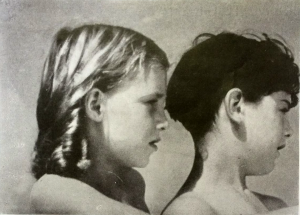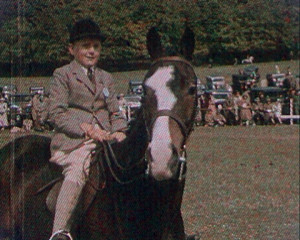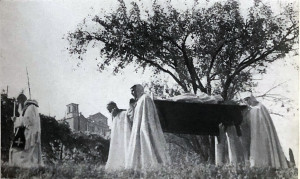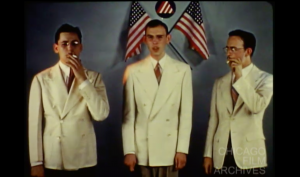
"a soggetto"/fiction
"Nuvola - Nuvola soggetto e regia di P. M. Pasinetti e Roberto Zerboni, fotografia di Francesco Cerchio, interpretato da due bambini, Giorgio Balboni e Liliana della Valle. Un cane e il solo altro personaggio della vicenda, e il film si vale di po-chi altri elementi per comporre il suo dramma: una barca, i cerchi, un fiore; e sopratutti iI sole e il mare: sia la vicenda che la sua trattazione si mantengono in un tono leggermente favoloso, che rimanda per certi aspetti a quel mondo che e proprio delle composizioni liriche di Roberto Zerboni, di cui anche noi abbiamo pubblicati vari esempi, e che sono seguite con moltissima attenzione dai bene informati. In senso cinematografico, la pellicola rispetta sempre una sobrietà di stile singolarmente accurata, e si vale quasi esclusivamente del sistema delle inquadrature fisse, studiando piuttosto la composizione e l'armonia del quadro, e mai cedendo alla retorica degli scorci o del montaggio inutilmente concitato, propria di varie produzioni sperimentali.”
"Cloud - Nuvola (Cloud), subject and direction by P. M. Pasinetti and Roberto Zerboni, photography by Francesco Cerchio, stars two children, Giorgio Balboni and Liliana della Valle. A dog is the only other character in the story, and the film makes use of a few other elements to compose its drama: a boat, circles, a flower, and above all the sun and the sea: both the event and its treatment are maintained in a slightly fabulous tone, which refers in some respects to that world that is proper to the lyrical compositions of Roberto Zerboni, of which we have published several examples, and which are followed with great attention by the well-informed. In the cinematographic sense, the film always respects a singularly accurate sobriety of style, and makes use almost exclusively of the system of fixed shots, studying rather the composition and harmony of the picture, but never yielding to the rhetoric of the foreshortening or of the uselessly excited editing, typical of various experimental productions.”
— Il ventuno 24 (Review of the G.U.F. of Venice) January 1935, p. 15

"The film includes shots of the departure of the riders in the early morning mist; the Master of Fox Hounds, Stanley Barratt, leading foxhounds by foot over a wooden bridge; riders and hounds patrolling a covert at Juniper Hill; the training of young hounds after a kill; horses and hounds assembling after the cubbing hunt. Scenes … include the meet in the early morning mist; the hounds by the wooden bridge; the location of the kill. A small crowd watches as a fox that has gone to ground is dug out; after the kill the fox’s body is thrown in the air for the hounds and a rider trains the young hounds. The films reference the same location, crowd (including two dogs, which are not foxhounds) and the same rider training the young hounds. Dufaycolor film of scenes from the Great Missenden Show of 1935. Shots include footage of some of the competitors in a junior show jumping event and the presentation of the prizes afterwards" (EAFA Database).
"endeavouring cinematically to depict the freedom of the open air as a contrast to the mechanised life of the city during the working week. The treatment in the hands of Mr. S. Sharples was a departure from the usual run of films, as there was exploitation only of natural media and no particular caste was featured. By rapid acceleration and accurate timing of sequences the effect of stimulation and movement was produced. This film was submitted to Mr. J. Grierson, of “Drifters” fame, and in a very candid criticism of it he wrote “… one of the most intelligent amateur films I have seen" (Anon 1931: 183).

"a soggetto"/fiction

"Three men encourage people to follow rules set by the air raid warden in the event of an air raid. The rules are put to song, and some rules are depicted by actors." Chicago Film Archives
"Objectif Festival is a story based - on truth or not, we don't know - of an old photographer who decides to bring his camera, tripod and all, the to the Cannes Film Festival to get a few still shots. He is not prepared for the fast shooting shutterbugs of today, nor the Bikini clad French dolls that litter the beaches. Time has passed him by in more ways than one. The film has been cleverly cut to fit its musical score, and this unusual editing has earned for the film the MPD Golden Scissors Award for the best film editing in the contest" PSA Journal, Sept. 1964, 50-51.
"This picture was a special delight as Miss Hill had concentrated upon pastel colors as she found them in the woods and fields. Also she brought the human element into her picture very gracefully and entertainingly." American Cinematographer, Dec. 1934, 377.
"L. Clyde Anderson was given an award for Color photography, for 'October By-Ways.' We want to congratulate Mr. Anderson for his selection of colors. It is one of the very first amateur pictures we have seen where color was really properly balanced. There were no harsh notes to distract, but he chose scenes where the ensemble blended and where there was a fine eye-resting blance of color and also color composition. It was obvious that Anderson used haze filters on his outside scenes as the sky does not have that postcard-blue effect, but has been reduced to almost a gray haze which helps the fall colors in the trees and does not take the eye away from the main points of interest." American Cinematographer, Jan. 1937, 37.
Total Pages: 299